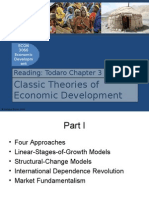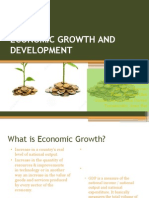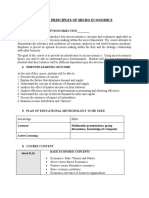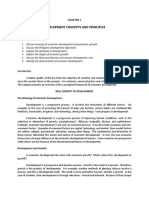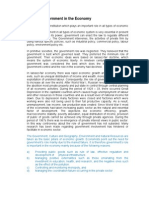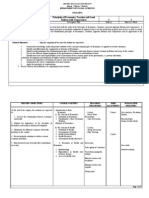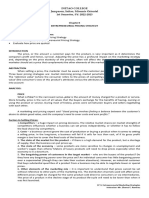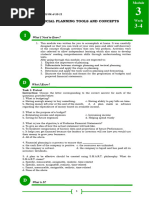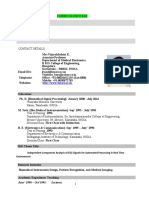Module 1 - Economic Development
Uploaded by
jessafesalazarModule 1 - Economic Development
Uploaded by
jessafesalazarEconomics 9 Name___________________________________ Score ____________ 4th Q
MODULE
1 Economic Development
It is often said that both the government and the citizen of any country aspire for economic development.
The Meaning of Economic Development
Economic growth is an increase in a country’s output of goods and services which can be caused by an increase in the
quantity or quality of factors of production. The growth rate of real gross domestic product (GDP) is the usual measure that
economists use to monitor the level of economic growth.
Economic development is a broader concept than economic growth. Economic development is concerned with both the
economic and social well-being of people of a specific area. Michael Todaro noted there are three core values of development,
namely, life-sustenance, self-esteem and freedom from servitude.
At present, the Human Development Index (HDI) is one of the most accurate measures used in monitoring the level of
economic development. Other methods of measuring development are also being used. The different methods of measuring
development take into account the factors which affect productivity that in turn could lead to economic growth.
Aspect Economic Growth Economic Development
Refers to Increase in the volume of production of Movement of income, savings, and investment together with
goods and services positive technological, social, and economic changes.
Factors Increase in consumption, government Increased score in the human development index, decreased
spending, investments, or net exports score in the Inequality Index, and changes that bring about
higher quality of life
Measurement Gross domestic product (Quantitative) Human Development Index, Inequality Index, infant mortality,
literacy rate, and others (quantitative and qualitative)
Effects Quantitative changes in the economy Quantitative and qualitative changes in the economy
Importance Measures improvements in the economy Measure improvements in the economy of developing
development of developed countries countries
Growth and Development: Some Important Differences
The table shows that there are some important differences between growth and development. In a way, economic growth is
just one aspect of economic development. Economic growth is a necessary but not a sufficient condition for economic development.
This means that while economic growth is needed to spur economic development, other factors must also be at play in order for
development to be attained.
Economic growth is basically an increase a country’s real level of national output or real GDP. Economic development, on
the other hand, takes into account improvements into account literacy and life expectancy as well as opportunities in the area of
education, healthcare, and employment. While the basic measure of economic growth (GDP) does not take into account the
depletion of natural resources and degradation of the environment, economic development, the concept of economic development
implies meeting the needs of the present generation without compromising the needs of the future generation.
HDI as a Measure of Development
The HDI is a tool to measure development which combines three basic dimensions of human development: longevity;
knowledge; a decent standard of living. The underlying idea is that the yardstick of income is an inadequate measure of human
development and that the appropriate measure should be a single statistic which should capture both social and economic
development.
The health component is measured by life expectancy at birth which compares the average number of years to be lived by a
group of people in the same year. Life expectancy at birth indicates the overall quality of life in a country.
The education component is measured by average of years schooling (for adults aged 25 years) and expected years of
schooling (for children at school entering age). Expected years of schooling is capped at 18 years.
The standard of living component is measured by gross national income (GNI) per capita. GNI is the sum of domestically-
generated income (GDP) and net income from abroad.
Countries fall into four broad human development categories: Very High Human Development, High Human Development,
Medium Human Development, and Low Human Development.
Factors of Economic Development
American economists Paul Samuelson and William Nordhaus listed four elements of development which operate in rich
and poor countries: human resources; natural resources; capital formation; and technology. It is important to note that for a
“developing country” like the Philippines, the combination of these elements differ in substantial way from those of developed
countries.
Human Resources
Samuelson and Nordhaus noted that countries with high population growth rate have a hard time overcoming poverty. The
rise in their GDP’s offset by the rise in population. It is therefore important that the government of these countries take an active
role in controlling population growth. Efforts toward voluntary reduction of birth rates should include improving the education of
women and making them aware of their rights.
Control of the quantity of human resources should be accompanied by improvement in their quality. This will require
improvement in the health of workers as well as the knowledge and skills they acquire through education and training.
Natural Resources
Samuelson and Nordhaus also emphasized the productive use of natural resources as a way of promoting economic
development. Since much of the labor force in developing countries are employed in farming, the productive use of land and
Econ 9 page 2 4th Q
opportunities for small farmers to own land would be important. A necessary component would be government support in terms of
provision of irrigation system and initiation of conservation practices.
Capital Formation
For an economy to develop, workers should be able to produce more goods and services. And workers are able to produce
more when they work with greater quantity of capital goods- equipment and structures used in production. Computers, machineries,
roads, and bridges make easier the production and distribution of goods and services.
In order for the country to increase the quantity of its capital goods, it must reduce consumption spending and use the
additional saving for more investment spending. However, for many developing countries, low incomes mean little can be saved for
capital formation.
Technology Change
Technological change is a crucial factor in economic development. Samuelson and Nordhaus noted that when it comes to
technological progress, developing countries could benefit from adapting the technological advances in developed countries.
They emphasized however that technological progress is not a simple matter of copying new and advance methods. In order
for developing countries to adapt more productive technologies of advanced nations, they foster entrepreneurship. Government set
up services that encourage and support people who are willing to take risk, innovate, or adapt new technologies. Technological
change thrives in a culture which appreciates the role or private initiative and profits.
FT1. In the table below, list 10 common economic issues in the country and propose a solution which you think is the best for the
Philippines.
Economic Problems/Issues Cause Solution
1.
2.
3.
4.
5.
6.
7.
8.
9.
10.
FT2. Construct a Venn Diagram depicting economic growth and economic development. Briefly explain the Venn diagram.
FT3. List in the box below the concepts that have something to do with economic development. Give priority to the concepts
learned in the earlier modules.
Basing on the concepts listed, draw a picture showing economic development.
Processing questions.
1. What are the criteria used in choosing the concepts listed above?
2. What do you think is the main difference between economic growth and economic development?
3. Has the Philippines attained economic development? Justify your answer.
FT4. Answer the following thoroughly.
1. Why has the Philippines Remained Relatively Poor?
2. Can there be economic growth without development?
3. What is considered as fundamental economic problem in the country?
4. What is HDI for? Do you think it would provide an accurate measurement to identify the development of a country? Discuss your
answers.
FT5. Create a composition paper that would describe your own definition of "Quality of Life". Discuss one personal problem that
changes your output in life and how did you overcome such. Cite your own examples of how one can achieve a quality life.
Note: Please use another sheet of paper for your answers.
-END-
HDI is divided into 4 tiers:
- 0.8- 1.0 = very human development
- 0.7- 0.79 = high human development
- 0.55 – 0.70 = medium human development
- Below 0.55 = low human development
Life expectancy- 0.7
Knowledge- 0.52
GNI- 0.79
You might also like
- Operation & Installation Manual For Wave Pool100% (3)Operation & Installation Manual For Wave Pool98 pages
- Module 3 - Filipino Approaches in The Social ScienceNo ratings yetModule 3 - Filipino Approaches in The Social Science3 pages
- Entrepreneurship and Human Development ReportNo ratings yetEntrepreneurship and Human Development Report56 pages
- Chapter 3 Classical Theories For Economic Growth and DevelopmentNo ratings yetChapter 3 Classical Theories For Economic Growth and Development6 pages
- Chapter 2 - Poverty, Inequality and Economic GrowthNo ratings yetChapter 2 - Poverty, Inequality and Economic Growth22 pages
- The History of Economic Thought & Development (Versoza)No ratings yetThe History of Economic Thought & Development (Versoza)41 pages
- Sales & Distribution Management - Module 2No ratings yetSales & Distribution Management - Module 240 pages
- Module 3 - Product Life Cycle in Theory and PracticeNo ratings yetModule 3 - Product Life Cycle in Theory and Practice11 pages
- Economic Growth Refers To An Increase in The CapacityNo ratings yetEconomic Growth Refers To An Increase in The Capacity24 pages
- Applied Economics: Quarter 1-Modules 1-6No ratings yetApplied Economics: Quarter 1-Modules 1-613 pages
- Identification, Evaluation and Selection of Business OpportunityNo ratings yetIdentification, Evaluation and Selection of Business Opportunity9 pages
- Nature Scope and Subject Matter of International Economics0% (1)Nature Scope and Subject Matter of International Economics2 pages
- This Syllabus Was Patterned From The Term 2 AY 2011-2012 Syllabus of Mr. Redencio B. Recio With Consent. Slight Modifications Were MadeNo ratings yetThis Syllabus Was Patterned From The Term 2 AY 2011-2012 Syllabus of Mr. Redencio B. Recio With Consent. Slight Modifications Were Made8 pages
- Chapter 3 Social Responsibility and Ethics in Strategic ManagementNo ratings yetChapter 3 Social Responsibility and Ethics in Strategic Management15 pages
- Introducing Economic Development - A Global Perspective100% (2)Introducing Economic Development - A Global Perspective17 pages
- Most Essential Learning Competency: 1. 2. 3No ratings yetMost Essential Learning Competency: 1. 2. 33 pages
- Role of Government in The Economy MBS First Year100% (1)Role of Government in The Economy MBS First Year27 pages
- 3 Political Economy and Economic Development100% (1)3 Political Economy and Economic Development31 pages
- Topic 3: Poverty, Inequality and DevelopmentNo ratings yetTopic 3: Poverty, Inequality and Development36 pages
- Economic Development Reviewer - Chapter 3 - Todaro and Smith100% (1)Economic Development Reviewer - Chapter 3 - Todaro and Smith6 pages
- Balance of Payments, Developing-Country Debt, and The Macroeconomic Stabilization ControversyNo ratings yetBalance of Payments, Developing-Country Debt, and The Macroeconomic Stabilization Controversy28 pages
- Applied Economics: Economics As A Social Science and As Applied ScienceNo ratings yetApplied Economics: Economics As A Social Science and As Applied Science6 pages
- Chapter4 - Entrepreneurial Pricing StrategyNo ratings yetChapter4 - Entrepreneurial Pricing Strategy4 pages
- Economic Growth of Nepal and Its Neighbours PDFNo ratings yetEconomic Growth of Nepal and Its Neighbours PDF12 pages
- 3rd Q.Lesson 3 - Finding The Right CareerNo ratings yet3rd Q.Lesson 3 - Finding The Right Career2 pages
- Module 3 - Social Relationships Among AdolescentsNo ratings yetModule 3 - Social Relationships Among Adolescents3 pages
- Module 1 - Dominant Approaches and Ideas in The Social ScienceNo ratings yetModule 1 - Dominant Approaches and Ideas in The Social Science3 pages
- Module 6 - Local and Global Work DemandsNo ratings yetModule 6 - Local and Global Work Demands1 page
- Module 5 - My Mission Makes Life Meaningful100% (1)Module 5 - My Mission Makes Life Meaningful2 pages
- Module 2 - Gaining From The Wise Use of TimeNo ratings yetModule 2 - Gaining From The Wise Use of Time1 page
- Applications of Thin Airfoil Theory - Part 1No ratings yetApplications of Thin Airfoil Theory - Part 128 pages
- Netter s Concise Radiologic Anatomy Netter Basic Science 1st Edition Edward Weber Do 2024 scribd downloadNo ratings yetNetter s Concise Radiologic Anatomy Netter Basic Science 1st Edition Edward Weber Do 2024 scribd download51 pages
- Yu Hua - On Brothers and Chaotic Aesthetics, (Chinese Literature Today, Spring 2011)No ratings yetYu Hua - On Brothers and Chaotic Aesthetics, (Chinese Literature Today, Spring 2011)6 pages
- 12 TH PPT of Foods and Industrial MicrobiologyCourse No. DTM 321 1No ratings yet12 TH PPT of Foods and Industrial MicrobiologyCourse No. DTM 321 122 pages
- AT Attachment With Packet Interface - 7 Volume 1No ratings yetAT Attachment With Packet Interface - 7 Volume 1390 pages
- Williams, Kenneth R. - The Natural Calculator (1991)100% (2)Williams, Kenneth R. - The Natural Calculator (1991)111 pages
- [Ebooks PDF] download The Event Manager s Bible How to Plan and Deliver an Event 2nd Edition Des Conway full chapters100% (8)[Ebooks PDF] download The Event Manager s Bible How to Plan and Deliver an Event 2nd Edition Des Conway full chapters85 pages





